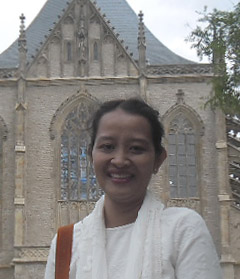Primary Care Indonesia – Recent Developments in 2014
 Dr Mora Claramita (pictured), from the Department of Medical Education at Gadjah Mada University in Yogyakarta, Indonesia, provides her perspectives on the recent changes for primary care doctors in Indonesia.
Dr Mora Claramita (pictured), from the Department of Medical Education at Gadjah Mada University in Yogyakarta, Indonesia, provides her perspectives on the recent changes for primary care doctors in Indonesia.
Background
Indonesia is one of the largest archipelagos; which is located in the Southeast Asian region and the fourth largest population in the world. Indonesia is included as having one of the highest maternal and infant mortality rates in this region.
1 More than 60% of male are active smokers, therefore lots of health problems related to smoking exposures including growth and development disorders of babies and toddlers.
2 However, on the 1st January 2014, a universal coverage health insurance system began and now drives primary care services in Indonesia to be better for the people.
3 In conjunction with that, we need high quality Primary Care Doctors, to be cost-effective, delivering high quality primary care and to meet the people expectations.
4 The task for Indonesia is enormous and unable to be done by medical doctors who only underwent six years of basic medical training. Therefore, the current 80,000 medical doctors who work in community settings are now preparing to be upgraded to Family Medicine Specialists/ General Practitioners equal to postgraduate training for other specialists.
Careful and serious consensus had been made by many stakeholders in Indonesia in choosing the appropriate name of “Primary Care Doctors”, suitable for Indonesian settings.
5 In such a huge nation like Indonesia, this ‘informed and shared decision making’ process; involving many parties, was challenging and took many years.
Current Development of the ‘Primary Care Doctors’ of Indonesia as the ‘Gate-Keepers’
Today we keenly await the National Board of Primary Care Doctors to be established by the Ministry of Education & Culture and the Ministry of Health. The National Board of Primary Care Doctors has been preparing:
(1) the standards for competence of the ‘Primary Care Doctor’; equal to Family Medicine Specialist,
(2) educational standards,
(3) Upskilling program for the existing doctors as well as for newly graduated doctors, and
(4) teacher training program as well as a benchmarking study.
Seventeen Faculties of Medicine in Indonesia have been prepared to open a new Department of Primary Care to start the specialization of what we call the ‘Primary Care Doctors’. Challenges are intensive coordination among both involved ministries, and the proper approach to other specialist colleagues; who are central; in regards to future inter-professional collaboration between primary, secondary and tertiary care settings. Potential internal conflict will be from current “General Practitioners” who may not wish to be further trained, or exposed to the latest evidence based medicine.
All current development mentioned above may be done by small number of faculty who look forward to the changes of better primary care. Apparently, good leadership is the key of change.6 The National Board of Primary Care Doctors of Indonesia may consist of younger doctors compared to American Board of Family Doctors or British National Board of General Practitioners in the mid 1900s; which no doubt mostly consisted of senior leaders.
“
Give me only 10 young men/women and I can change the world.” Soekarno (The first President Republic of Indonesia).
We should celebrate and pray for the coming birth of Primary Care Doctors of Indonesia. May it be free of internal conflict.
Acknowledgement:
Our great gratitude to Professors Mark Alan Graber, Lisa Soldat and Jason Wilbur from the University of Iowa, US who have been training our current GPs to rise to being Family Medicine Specialists; since 2010, on a voluntary basis. Our highest appreciation for Professor Job Metsemakers from Maastricht University, The Netherlands who has been thinking with us for finding the 10 young people who strive for better primary care in Indonesia. Great thanks to Professor Michael Kidd from Flinders University Australia who has been our role model of a leader with strong determination for primary care development. Big thanks to Omneya El Sherif, Jachin Velavan and Page Morahan at the FAIMER Institute, Philadelphia for sharing their story of development of primary care in Egypt, India and throughout the world.
References:
1. Chongsuvivatwong V1, Phua KH, Yap MT, Pocock NS, Hashim JH, Chhem R, Wilopo SA, Lopez AD. Health and health-care systems in Southeast Asia: diversity and transitions. Lancet. 2011 Jan 29;377(9763):429-37.
2. Southeast Asia Tobacco Control Alliance (SEATCA). The ASEAN Tobacco Control Report 2012. Bangkok: SEATCA
3. Indonesian National Act of Implementing Unit of Universal Coverage No 24, 2011. (Country Decree. No. 116, 2011 and Additional Country Decree No. 5256)
4. Starfield B, Shi L, Machinko J. Contribution of Primary Care to Health System and Health. The Milbank Quarterly 2005, Vol. 83, No. 3: 457–502
5. Indonesian National Act of Medical Education No 20, 2013 (Country Decree No. 132, 2013 and additional Country Decree No. 5434)
6. WHO. Primary Health Care is Now More than Ever. 2008
Mora Claramita
Department of Medical Education
Team of Family Medicine, Faculty of Medicine Gadjah Mada University
Fulbright Senior Research Scholar 2013-2014 at The University of Iowa, Carver College of Medicine Department of Family Medicine, US
Radiopoetro Building 6th floor, Jalan Farmako, Sekip Utara, Yogyakarta 55281, Indonesia
Email:
mora.claramita@ugm.ac.id